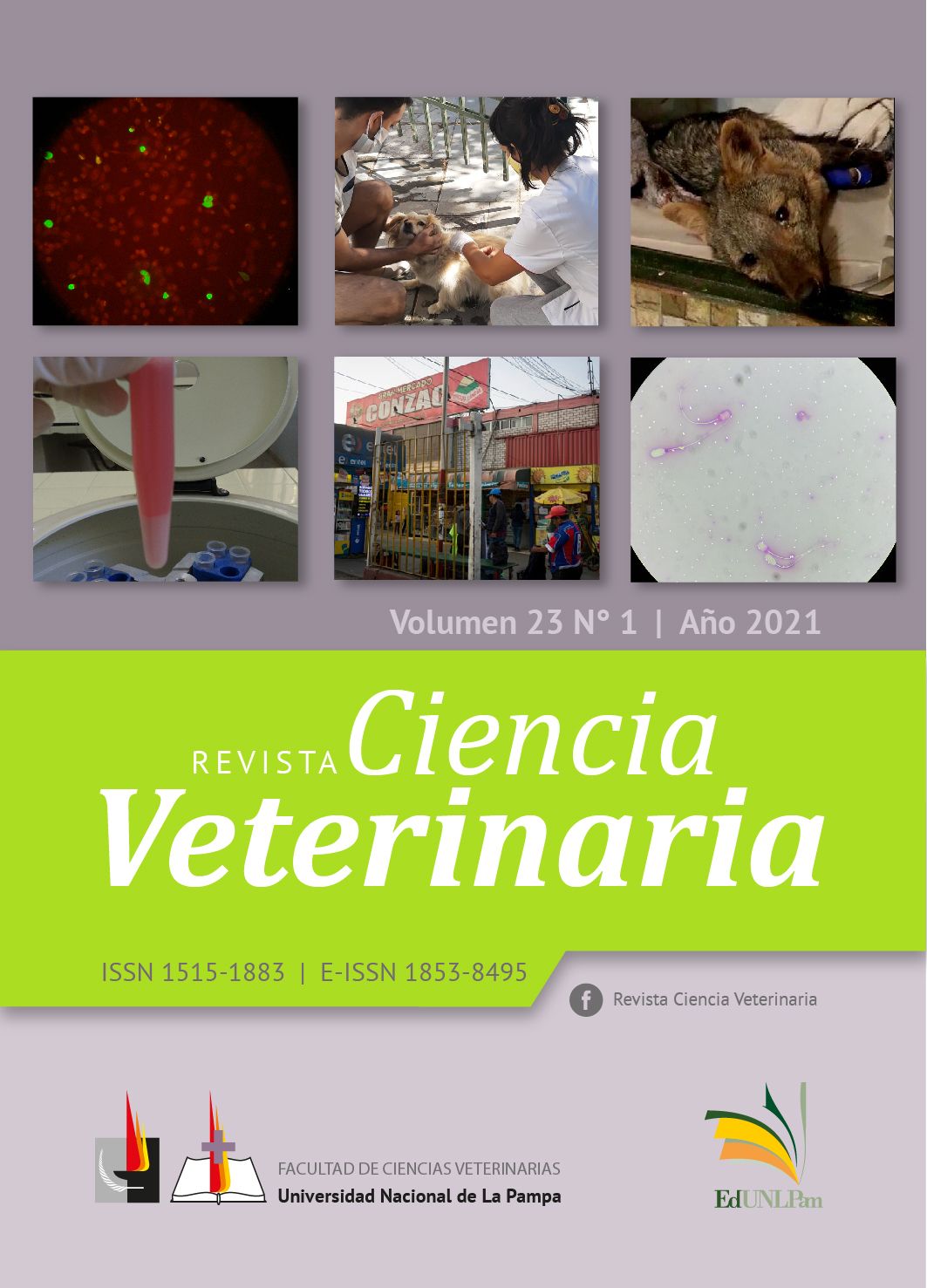Report of the first case of canine distemper in bush fox
DOI:
https://doi.org/10.19137/cienvet202123105Keywords:
Cerdocyon thous, distemper, Puerto Iguazú, Argentine RepublicAbstract
The bush fox (Cerdocyon thous) is a wild canid that is present in the province of Misiones. Like many other species in the order of the carnivores, foxes are susceptible to the Canine Distemper Virus (CDV). The objective of this work is to communicate and describe the first CDV case in a free-living bush fox (C. thous), found in a peri-urban area of the city of Puerto Iguazú.
Downloads
References
Summers BA, Appel MJ. Aspects of canine distemper virus and measles virus encephalomyelitis. Neuropathology and Applied Neurobiology. Oxford.1994. 20 (6):
-534.
Van De Bildt MWG, Kuiken T, Visee AM, Lema S, Fitzjohn TR, Osterhaus, MADE. Distemper outbreak and its effect on African wild dog conservation. Emerging Infectious Diseases.2002. 8: 211–213.
Cannevari M, Vaccaro O. Guía de mamíferos del sur de América del Sur. 2002. Editorial L.O.L.A.
Massoia EJC, Chebez A.Los Mamíferos Silvestres de la Provincia de Misiones, Argentina. Fundación de Historia Natural Félix de Azara. 2012. Buenos Aires.
Megid J, Feijó de Souza VA, Teixeira A, Ceortez R L, Amorin MB, Heinemman DQ Cagnini and LJ Richtzenhain. Canine distemper virus in a crab-eating fox (Cerdocyon
thous) in Brazil: Case report and phylogenetic analyses. Journal of Wildlife Diseases.
40: 527-530.
Megid J,Teixeira A, Cortez MB, Heinemann JMAP, Antunes F, Fornazari FB, Rassy and
LJ Richtzenhain. Canine distemper virus infection in a lesser grison (Galictis cuja):
first report and virus phylogeny. Pesq. Vet. Bras.2012. 33(2): 247-250.
Ferreyra H, Calderón MG, Marticorena C, Marull, & CL Barrios.Canine Distemper Infection in Crab-eating Fox (Cerdocyon thous) from Argentina. Journal of Wildlife Diseases. 2009. 45(4): 1158 – 1162.
Berríos PE, Pincheira BL. Distemper canino y su impacto en a fauna silvestre. Científica. 2016.13 (2)
Fox JG, Pearson RC & Gorham JR. Distemper In: Fox J.G. (Ed.) Biology and Diseases of
the Ferrets. Blackwell Publishers.1998:355-374.
Roelke-Parker ME, Munson C, Packer R, Kock S, Cleaveland M, Pospischill, R. et al. 1
A canine distemper virus epidemic in Serengeti lions. Nature.1996. 379: 441– 445.
Mamaev LV, Denikina SI, Belikov VE, Volchkov LK, Visser M, Fleming C. Characterization of morbilliviruses isolated from Lake Baikal’s seals (Phoca sibirica). Veterinary Microbiology.1995. 44: 251–259.
Bengston JL, Boveng U, Frankzen P, Have MP, Heide-Jorgense. Antibodies to canine
distemper virus in Antarctic seals. Marine Mammal Science.1991.71: 85–88.
Alexander KA, PA Conrad, IA, Gardner C, Parish M, Appel MG, Levy, N. et al. Serologic
survey for selected microbial pathogens in African wild dogs (Lyacon pictus) and
sympatric domestic dogs (Canis familiaris) in Maasai Mara, Kenya. Journal of Zoo and
Wildlife Medicine. 1993. 24: 140–44.
Laurenson K, C. Sillero-Zubiri H., Thompson F, Shiferaw S, Thirgood and J. Malcolm.
Disease as a threat to endangered species: Ethiopian wolves, domestic dogs, and canine pathogens. Animal Conservation.1998. 1: 273–280.
Cleaveland S, MJG. Appel WSK, Chalmers C, Chillingworth M, Kaare and C. Dye. Serological and demographic evidence for domestic dogs as a source of canine distemper virus infection for Serengeti wildlife. Veterinary Microbiology. 2000. 72: 217–227.
Nigro NA, NL Ocampo G, Martínez LM. Primer registro documentado de Aguará guazú (Chrysocyon brachyurus) para la ecorregión de la Selva Paranaense, en la provincia de Misiones, República Argentina. 2020. Notas sobre mamíferos sudamericanos. Disponible en: http://doi.org/10.31687/saremNMS.20.0.33
Downloads
Published
How to Cite
Issue
Section
License
Al momento de enviar sus contribuciones, los colaboradores deberán declarar , de manera fehaciente, que poseen el permiso del archivo o repositorio donde se obtuvieron los documentos que se anexan al trabajo, cualquiera sea su formato (manuscritos inéditos, imágenes, archivos audiovisuales, etc.), permiso que los autoriza a publicarlos y reproducirlos, liberando a la revista y sus editores de toda responsabilidad o reclamo de terceros , los autores deben adherir a la licencia Creative Commons denominada “Atribución - No Comercial CC BY-NC-SA”, mediante la cual el autor permite copiar, reproducir, distribuir, comunicar públicamente la obra y generar obras derivadas, siempre y cuando se cite y reconozca al autor original. No se permite, sin embargo, utilizar la obra con fines comerciales.







4.png)


7.png)



